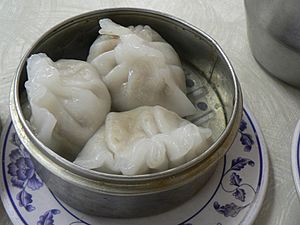Fun guo facts for kids

A steaming tray with three fun guo
|
|
| Alternative names | Chaozhou fun guo, fun quor, fun gor, fen guo, Chiu Chow dumpling, Teochew dumpling, hung gue, fun kor |
|---|---|
| Course | Yum cha |
| Place of origin | Chaoshan area, Guangdong, Southern China |
| Created by | Teochew people |
| Main ingredients | Filling: chopped peanuts, garlic chives, ground pork, dried shrimp, dried radish and shiitake mushrooms Wrap: de-glutenized wheat flour, tapioca flour, and corn or potato starch |
| Fun guo | |||||||||||||||
|---|---|---|---|---|---|---|---|---|---|---|---|---|---|---|---|
| Traditional Chinese | 潮州粉粿 | ||||||||||||||
|
|||||||||||||||
Fun guo is a delicious type of dumpling that comes from the Chaoshan area in Guangdong, a province in Southern China. It is also known as Chaozhou fun guo or Teochew dumpling. These dumplings are usually steamed and look a lot like har gaw, which are popular shrimp dumplings found in Cantonese-style dim sum.
Contents
What is Fun Guo?
Fun guo is a special kind of dumpling with a unique filling and wrapper. The wrapper is often made from a mix of wheat flour, tapioca flour, and corn or potato starch. This mix gives the wrapper a slightly chewy and translucent (see-through) texture when cooked.
Delicious Fillings
The inside of a fun guo is packed with tasty ingredients. Common fillings include chopped peanuts, garlic chives, ground pork, dried shrimp, dried radish, and shiitake mushrooms. These ingredients create a savory and satisfying flavor.
Where Does Fun Guo Come From?
Fun guo is a traditional dish of the Teochew people, who live in the Chaoshan region of Guangdong, China. This area is known for its unique and flavorful cuisine.
Teochew Cuisine and Names
In the Chaozhou dialect, which is spoken by the Teochew people, these dumplings are called hung gue. However, they are more widely known by their Cantonese name, fun guo. You can find these dumplings not only in the Chaoshan region but also in other parts of Guangdong.
Fun Guo in Hawaii
Interestingly, fun guo has also made its way to Hawaii. There, it is known as pepeiao. This Hawaiian word means "ear," and the dumpling got this name because its shape often looks like an ear!
See also
 In Spanish: Fun guo para niños
In Spanish: Fun guo para niños

